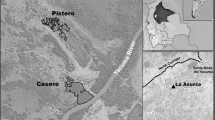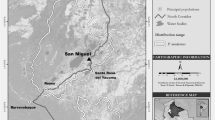Abstract
Spider monkeys (Ateles) frequently use suspensory locomotion and postures, and their postcranial morphology suggests convergence with extant hominoids in canopy and food utilization. Previous studies of positional behavior in Ateles, have produced variable rates in the use of different positional activities. I investigated the positional behavior of black spider monkeys (Ateles paniscus) in a wet rain forest in French Guiana, and assessed differences in the rates of use of positional modes across studies. I also discuss the significance of suspensory activities in forest utilization. In French Guiana, Ateles confined travel and feeding locomotion on small and medium-sized moderately inclined supports in the main canopy. Tail-arm brachiation and clamber were their main traveling modes, while clamber was the dominant feeding locomotor mode. Small horizontal supports were predominant during their feeding. Suspensory postures accounted for more than half of feeding bouts, with tail-hang and tail-hind limb(s) hang being the dominant postures. Feeding occurred largely in tree crown peripheries with the prehensile tail anchored frequently above the monkey. They usually collected food items below or at the same level as the body. There is no difference among the postures they used to acquire and eat young leaves and fruit. My results agree with reports on the positional behavior of different species of spider monkeys at other sites. Despite the use of different methods, the same species exhibited more or less similar profiles in similar forests. Interspecific differences could be associated with morphological differences. Moreover, intraspecific differences could be attributed to forest structure. The findings suggest that the major part of biological information is independent of methods used in the several studies. Suspensory behavior facilitates the exploitation of the forest canopy by shortening traveling pathways between and within trees, by enabling faster travel for the better exploitation of patchy food sources and by providing access to food in the flexible terminal twigs.
Similar content being viewed by others
REFERENCES
Begun, D. (1993). New catarrhine phalanges from Rudabanya (Northeastern Hungary) and the problem of parallelism and convergence in hominoid postcranial morphology. J. Hum. Evol. 24: 373–402.
Bergeson, D. J. (1996). The Positional Behavior and Prehensile Tail Use of Alouatta palliata, Ateles geoffroyi, and Cebus capucinus, PhD. Dissertation, Washington University, St. Louis. 1092 Youlatos
Bergeson, D. J. (1998). Patterns of suspensory feeding in Alouatta palliata, Ateles geoffroyi, and Cebus capucinus. In Strasser, E., Fleagle, J. G., Rosenberger, A., and McHenry, H. (eds.), Primate Locomotion. Recent Advances, Plenum Press, New York, pp. 45–60.
Cant, J. G. H. (1986). Locomotion and feeding postures of spider and howling monkeys: Field study and evolutionary interpretation. Folia Primatol. 46: 1–14.
Cant, J. G. H. (1987). Positional behavior of female Bornean orangutans. Am. J. Primatol. 12: 71–90.
Cant, J.G. H. (1990). Feeding ecology of spider monkeys (Ateles geoffroyi) at Tikal, Guatemala. Hum. Evol. 5: 269–281.
Cant, J. G. H. (1992). Positional behavior and body size of arboreal primates: A theoretical framework for field studies and an illustration of its application. Am. J. Phys. Anthropol. 88: 273–283.
Cant, J. G. H., Youlatos, D., and Rose, M. D. (2001). Locomotor behavior of Lagothrix lagothricha and Ateles belzebuth in Yasuni National Park, Ecuador: General patterns and nonsuspensory modes. J. Hum. Evol. 41: 141–166.
Cartmill, M. (1985). Climbing. In Hildebrand, M., Bramble, D. M., Liem, K. F., and Wake, D. B. (eds.), Functional Vertebrate Morphology, Belknap Press, Cambridge, pp. 73–88.
Cartmill, M., and Milton K. (1977). The lorisiform wrist joint and the evolution of 'brachiating' adaptations in the Hominoidea. Am. J. Phys. Anthropol 47: 249–272.
Dagosto, M., and Gebo, D. L. (1998). Methodological issues in studying positional behavior. In Strasser, E., Fleagle, J. G., Rosenberger, A., and McHenry, H. (eds.), Primate Locomotion. Recent Advances. Plenum Press, New York, pp. 5–29.
Dunbar, D. C., and Badam, G. L. (2000). Locomotion and posture during terminal branch feeding. Int. J. Primatol. 21: 649–669.
Erikson, G. E. (1963). Brachiation in NewWorld primates and in anthropoid apes. Symp. Zool. Soc. Lond. 10: 135–163.
Fleagle, J. G. (1976). Locomotion and posture of the Malayan siamang and implications for hominoid evolution. Folia Primatol. 26: 245–269.
Fleagle, J. G. (1988). Primate Adaptation and Evolution, Academic Press, New York.
Fleagle, J. G., and Mittermeier, R. A. (1980). Locomotor behavior, body size, and comparative ecology of seven Surinam monkeys. Am. J. Phys. Anthropol. 52: 301–314.
Fontaine, R. (1990). Positional behavior in Saimiri boliviensis and Ateles geoffroyi Am. J. Phys. Anthropol. 82: 485–508.
Gebo, D. L. (1992). Locomotor and postural behavior of Alouatta palliata and Cebus capucinus. Am. J. Primatol. 26: 277–290. Grand, T. I. (1972). A mechanical interpretation of terminal branch feeding. J. Mamm. 53: 198-201.
Grand, T. I. (1984). Motion economy within the canopy:Four strategies for mobility. In Rodman, P. S., and Cant, J. G. H. (eds.), Adaptations for Foraging in Nonhuman Primates, Columbia University Press, New York, pp. 54–72.
Hunt, K. D. (1991). Positional behavior in the Hominoidea. Int. J. Primatol. 12: 95–118.
Hunt, K.D. (1992). Positional behavior of Pan troglodytes in the Mahale mountains and Gombe Stream National Parks, Tanzania. Am. J. Phys. Anthropol. 87: 83–105.
Hunt, K. D., Cant, J. G. H., Gebo, D. L., Rose, M. D., Walker, S. E., and Youlatos, D. (1996). Standardized descriptions of primate locomotor and postural modes. Primates 37: 363–387.
Jenkins, F. A., Jr. (1981). Wrist rotation in primates:Acritical adaptation for brachiators. Symp. Zool. Soc. Lond. 48: 429–451.
Jungers, W. L. (1985). Body size and scaling of limb proportions in primates. In Jungers, W. L. (ed.), Size and Scaling in Primate Biology, Plenum Press, New York, pp. 345–381.
Larson, S. G. (1998). Parallel evolution in the hominoid trunk and forelimb. Evol. Anthrop. 6: 87–99.
Lewis, O. J. (1989). The Functional Anatomy of the Evolving Hand and Foot, Clarendon Press, Oxford.
McGraw, W. S. (1998). Posture and support use of OldWorld monkeys (Cercopithecidae): The influence of foraging strategies, activity patterns, and the spatial distribution of preferred food items. Am. J. Primatol. 46: 229–250.
Mehta, C., and Patel, N. (1995). StatXact-3 for Windows. User Manual, Cytel Software Corporation, Cambridge, MA.
Mittermeier, R. A. (1978). Locomotion and posture in Ateles geoffroyi and Ateles paniscus. Folia Primatol. 30: 161–193.
Preuschoft, H. (1990). Gravity in primates and its relation to body shape and locomotion. In Jouffroy, F. K., Stack, M. H., and Niemitz, C. (eds.), Gravity, Posture and Locomotion in Primates, Il Sedicesimo, Firenze, pp. 109–127.
Roosmalen, van., M. G. M. (1985). Habitat preferences, diet, feeding strategy and social organization of the black spider monkey (Ateles paniscus paniscus Linnaeus 1758) in Surinam. Acta Amaz. 15(Suppl.): 1–238.
Rose, M.D. (1993). Locomotor anatomy of Miocene hominoids. In Gebo, D.L. (ed.), Postcranial Adaptation in Nonhuman Primates, Northern Illinois University Press, DeKalb, pp. 252–272.
Rose, M. D. (1994). Quadrupedalism in some Miocene catarrhines. J. Hum. Evol. 26: 387–411.
Rosenberger, A. L., and Strier, K. B. (1989). Adaptive radiation of the ateline primates. J. Hum. Evol. 18: 717–750.
Sarmiento, E. E. (1995). Cautious climbing and folivory: A model of hominoid differentiation. Hum. Evol. 10: 289–321.
Smith, R. J., and Jungers, W. L. (1997). Body mass in comparative primatology. J. Hum. Evol. 32: 523–559.
Strier, K. B. (1992). Atelinae adaptations: Behavioral strategies and ecological constraints. Am. J. Phys. Anthropol 88: 515–524.
Temerin, L. A., and Cant, J. G. H. (1983). The evolutionary divergence of OldWorld monkeys and apes. Am. Nat. 122: 335–351.
Youlatos, D. (1993). Passages within a discontinuous canopy: Bridging in the red howler monkey (Alouatta seniculus). Folia Primatol. 61: 144–147.
Youlatos, D. (1994). MaitrÍse de l'Espace et Acc`es aux Ressources chez le Singe Hurleur Roux (Alouatta seniculus) de la Guyane Française. Etude Morpho-fonctionnelle, PhD Dissertation, Muséum National d'Histoire Naturelle, Paris.
Youlatos, D. (1996). Atelines, apes, and wrist joints. Folia Primatol. 67: 193–198.
Youlatos, D. (1999). Comparative locomotion of six sympatric primates in Ecuador. Ann. Sci. Nat. (Zool.) 20: 161–168.
Youlatos, D. (2000). Functional anatomy of forelimb muscles in Guianan Atelines (Platyrrhini, Primates). Ann. Sci. Nat. (Zool.) 21: 137–151.
Zhang, S.-Y. (1995). Activity and ranging patterns in relation to fruit utilization by brown capuchins (Cebus apella) in French Guiana. Int. J. Primatol. 16: 489–507.
Author information
Authors and Affiliations
Rights and permissions
About this article
Cite this article
Youlatos, D. Positional Behavior of Black Spider Monkeys (Ateles paniscus) in French Guiana. International Journal of Primatology 23, 1071–1093 (2002). https://doi.org/10.1023/A:1019602116805
Issue Date:
DOI: https://doi.org/10.1023/A:1019602116805




